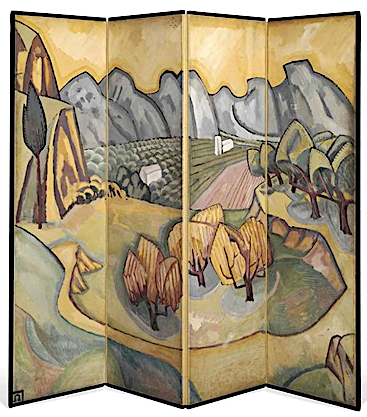ALEXANDRE CALAME (1810-1864)
The Wetterhorn (3,692m-12,113ft)
Switzerland
In "In het Berner Oberland" (1847) Oil on canvas, 78 x 100 cm , Amsterdam Museum
The Mountain
The
Wetterhorn (3,692m-12,113ft) in the Bernese Alps, towers above the
village of Grindelwald. Formerly known as Hasle Jungfrau, it is one of
three summits of a mountain named Wetterhorn sensu lato, or the
"Wetterhцrner", the highest summit of which is the Mittelhorn (3,704 m)
and the most distant the Rosenhorn (3,689 m). The Mittelhorn and
Rosenhorn are mostly hidden from view from Grindelwald. The Grosse
Scheidegg Pass crosses the col to the north, between the Wetterhorn and
the Schwarzhorn.
Climbing
The Wetterhorn summit was first reached on August 31, 1844, by the
Grindelwald guides Hans Jaun and Melchior Bannholzer, three days after
they had co-guided a large party organized by the geologist Edouard
Desor to the first ascent of the Rosenhorn. The Mittelhorn was first
summitted on 9 July 1845 by the same guides, this time accompanied by a
third guide, Kaspar Abplanalp, and by Stanhope Templeman Speer. The son
of a Scottish physician, Speer lived in Interlaken, Switzerland.
A September 1854 ascent by a party including Alfred Wills is much
celebrated in Great Britain. Apparently believing to be the first
ascendant, Wills' description of this trip in his book "Wanderings Among
the High Alps" (published in 1856) helped make mountaineering
fashionable in Britain and ushered in the systematic exploration of the
Alps by British mountaineers, the so-called golden age of alpinism.
Despite several well-documented earlier ascents and the fact that he
was guided to the top, even in his obituary in 1912 he was considered to
be "certainly the first who can be said with any confidence to have
stood upon the real highest peak of the Wetterhorn proper" (i.e. the
3,692 m summit). In a subsequent corrigendum, the editors admitted two
earlier ascents, but considered his still "the first completely
successful" one.
In 1866, Lucy Walker was the first documented female ascendant of the peak.
The 24-year-old English mountaineer William Penhall and his Meiringen
guide Andreas Maurer were killed by an avalanche high up on the
Wetterhorn on 3 August 1882.
The famed guide and Grindelwald native Christian Almer climbed the
mountain many times in his life, including on his first of many trips
with Meta Brevoort and her nephew W. A. B. Coolidge in 1868. His last
ascent was in 1898 at the age of 70 together with his wife to celebrate
their golden anniversary on top. Winston Churchill is also supposed to
have climbed the Wetterhorn in 1894.
The painter
Alexandre Calame
was a Swiss painter. He was the son of a skillful marble worker in
Vevey. His father lost the family fortune, and Alexandre Calame was
forced to work in a bank at the age of 15. When his father fell from a
building and then died, the young Calame provided for his mother.
In his spare time he began to practice drawing small views of
Switzerland. In 1829 he met his patron, the banker Diodati, who made it
possible for him to study under landscape painter François Diday. After a
few months he decided to devote himself fully to art.
In 1835, he
began exhibiting his Swiss-Alps and forest paintings in Paris and
Berlin. He became quite well known, especially in Germany, although
Calame was more a drawer than an illustrator. He is associated with the
Dusseldorf school of painting. In 1842 he went to Paris and displayed
his works Mont Blanc, the Jungfrau, the Brienzersee, the Monte Rosa and
Mont Cervin. He taught in Geneva, where Adolf Mosengel was one of his
pupils.
He went to Italy in 1844 and brought back from Rome and
Naples countless paintings, among them one of the ruins of Paestum (in
the city museum in Leipzig). He showed that he was capable of
understanding Italian nature; but the Alps remained his speciality.
The glaciers, emerald-green, white foaming mountain water, which split
the trees during the storm, and the whipped clouds, the multi-colored
rocks, half masked from fog, in the rays of the gleaming sun, are those
things, which he knew to be true to nature.
One of his most
ingenious works is the representation of the four seasons and times of
the day in four landscapes, a spring morning in the south, a summer
midday in the Nordic flatlands, an Autumn evening, and a winter night on
a mountain. He became popular with these large works, and his
popularity grew with smaller pieces and lithographies, namely 18 studies
of Lauterbrunnen and Meiringen and the 24 sheets of Alpine passes.
These were widespread in France, England, and Germany and are still
today used to teach this style of painting.
He died in Menton,
France in 1864. An exhibition featuring more than thirty of Calame's
paintings was held at the Sterling and Francine Clark Art Institute in
Williamstown, Massachusetts in 2006.
______________________________
2020 - Wandering Vertexes...
by Francis Rousseau








